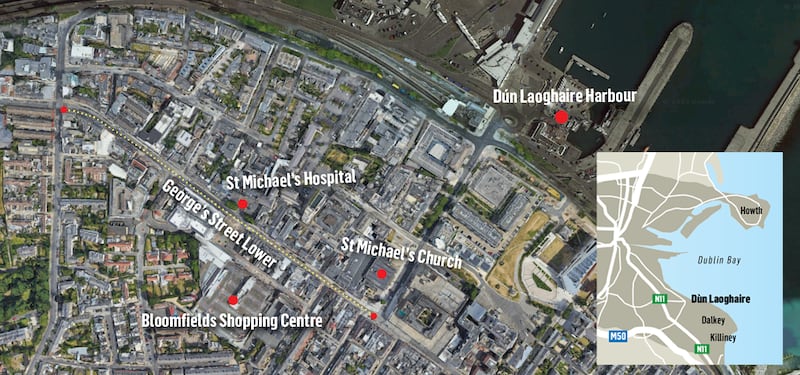A pair of shops on opposite sides of Dún Laoghaire’s main street have come to represent the stark contrasts in the south Dublin town.
On George’s Street Lower, between Dún Laoghaire shopping centre and St Michael’s Hospital, stands a new shop front. In the redeveloped building is a trio of hand-painted signs for three businesses in the newly renovated property: Harbour Books, a health and wellbeing care centre, and George’s Street Studios.
Directly across the road lies a very different shop front. What used to be a shoe shop is now an empty retail unit. In recent weeks, a sign promoting the new tenant, Smart Shop, featuring the promotion of vaping products, has been placed on the property. Smart Shop is expected to open in the near future.
Dominico Rea, owner of the nearby Miami Cafe, calls the display an “eyesore”. Local councillor Tom Kivlehan of the Green Party has referred the advertisement to the planning enforcement body.
READ MORE
For many, the two buildings show two different sides of Dún Laoghaire. On one hand, the town – despite its size and proximity to popular coastal amenities – is characterised by empty shops and dereliction. On the other, many local businesses are doing what they can to rejuvenate the street.

When it opened in 1976, Dún Laoghaire’s was just the second shopping centre in the country. Seen as cutting edge at the time, it brought business to the both to the centre and the nearby high street.

“I hung around here in the 1980s and Dún Laoghaire was an absolutely bustling, thriving town,” remembers People Before Profit’s Richard Boyd Barrett, one of the town’s local TDs.
In recent years, the number of businesses in the shopping centre has dwindled – a decline mirrored across the town.
‘Poor architectural quality’
According to the Dún Laoghaire-Rathdown County Council’s urban structure plan, the shopping centre is “of poor architectural quality” and the “successful regeneration of the town centre” is dependent on addressing problems within the facility.
“What architect in the early 1970s thought it was a good idea to build a block of a shopping centre with wrought iron grids on the windows, to build a car park that looks like a prison?” asked Brendan Kerrigan, owner of The Pen Place.
Kerrigan says he is happy doing business in the centre despite being one of the few remaining shops on the top floor, now dominated by healthcare clinics run by the HSE and a private practice.
“When this shopping centre was built, it was state of the art. Since then we have had shopping centres built on the periphery of every small town in the country, especially on the east coast.”
The most damaging impact from the growth of other shopping centres and the one most often referenced by locals in Dún Laoghaire is Dundrum Town Centre, a 25-minute drive away.
“That sucked an awful lot of business out of all the other shopping centres in the Greater Dublin Area,” says Kerrigan.
Local business owners say other factors behind the demise of both Dún Laoghaire shopping centre and the high street include the increase in online shopping, the M50 ring road that gives shoppers easier access around Dublin, and the economic downturns, both in 2008 and during the pandemic.
Housing crisis
The country’s housing crisis has also played a role, says Boyd Barrett.
“Working people have been driven out of the area because of the high rents and the lack of affordable housing – that has detrimentally impacted on the high street,” he says.
“The local community was hollowed out to a very significant extent.
“What you had then was a population being replaced with people who were professionals who might have been working in IT, working in town; yes, they might live in Dún Laoghaire but they didn’t spend a lot of money or a lot of time in Dún Laoghaire. They have been able to work from home, but that’s temporary – we will see what are the long-term consequence of that.”

Despite the decline, many believe Dún Laoghaire has turned the corner. The number of empty units on the high street is falling, while businesses that have been in operation for long periods are leading the way in improving the town’s image.
Ekaterina Voronova and Ross Cahill-O’Brien, architects who work from George’s Street Studios and who designed that building’s new shopfront, say they did not do it for their own benefit. As architects who work above the two ground-floor shops, they don’t rely on business coming in from the street.
“We don’t need that at all,” says Voronova.
“You don’t always do what’s good for your business; you do it because it’s the right thing to do, because we like Dún Laoghaire, because we are architects. We want to make change.”
“When the guys were painting the shop front, the comments from the public were very positive,” said Cahill-O’Brien. “It’s such a positive thing for people passing by to say that.”
“The town is crying out for it,” adds Voronova.
‘Responded really well’
Next door to the architects is the Miami Cafe. Dominico Rea runs the chipper, which has been owned by various Italian families since 1913. He, too, has redesigned his shopfront in recent years.
“However your building looks at the front says a lot about your business,” he says. “Everybody responded really well to it and a lot of the younger people started coming back in.”
Me, as a signwriter, I can’t grasp how some businesses don’t realise they need a nice shopfront. It’s not a case of people want a bad shop front; they just don’t know any better
— Cormac Dillon, of Mack Signs
Miami Cafe is also located close to the controversial sign above the empty Smart Shop opposite. Representatives for the shop’s owners were contacted by The Irish Times seeking comment on their future plans for the building but they did not respond.
“Everyone’s complaining about that, it’s shocking,” says Rea. “But, 15 years ago, that wouldn’t have been frowned upon. That’s how the street has changed.”
Cormac Dillon of Mack Signs is an artist who hand-painted a number of shop fronts in the town, including both George’s Street Studios and Miami Cafe.
“Me, as a signwriter, I can’t grasp how some businesses don’t realise they need a nice shopfront,” he says.
“It’s not a case of people want a bad shop front; they just don’t know any better. I do think that people who take the little extra time and care, it does pay off on their business. People do notice.”
‘Younger crowd’
While some businesses have recorded an uptick in trade from the front-facing developments, others have found different ways to grow. Michael O’Loughlin says his pub, O’Loughlin’s, improved its fortunes when he introduced an outdoor beer garden.
“It has been very busy. We get a younger crowd now. We have never seen them, ever, and now it is college people coming in. They have all made it their little space to come in.”
While businesses have found ways to flourish once more, the council has its own plans. Its capacity to redevelop the shopping centre, given that it is private property, are limited.
Yet at the other end of the town, Myrtle Square, outside Bloomfields Shopping Centre and the IMC Cinema, is currently being developed into a public square, including a children’s playground and a large yellow structure which already looms over George’s Street.
“If you go to anywhere around the world, you always see structures and think ‘What is that?’,” says Rea. “It’s a focal point, it’s a place where we can hang out, a piazza.”
O’Loughlin sees it as “another attraction for people to come and look at” rather than “nothing” being there and “walking through a dead town”, he says.
In September, the council will decide on a contentious plan to close George’s Street to cars from the top of Marine Road (at the shopping centre) down to the hospital. The pedestrianization of the high street has encountered plenty of opposition, despite local councillor Kivlehan labelling it a success when first trialled during the pandemic.
“We are looking at making it a people-friendly town as opposed to a car-friendly town,” he says.
“Towns around Ireland that are successful, they have a pedestrian core, they make it safe for their families to bring kids with them, it’s a walkable town, that’s what we’re hoping to do here.”
‘Cautiously optimistic’
Niall Lawlor, partner franchise holder for Danish homeware store Sostrene Green in Ireland, says he is “cautiously optimistic” about pedestrianization.
The big concern is car traffic management. If you pedestrianise a very mature area, you are going to have ripple effects of where that traffic goes
— Niall Lawlor, partner franchise holder for homeware store Sostrene Green
Lawlor explains that the local council has installed foot-traffic counters that he believes will be pivotal to determining the success of the project, should it go ahead.
[ People returning to towns and shopping centres in significant numbersOpens in new window ]
[ Four country towns win ‘Town Centre Living’ awards for their architectural plansOpens in new window ]
“Everyone wants more foot traffic in the town, the question is how to get it down there. How do you satisfy residents and businesses? The big concern is car traffic management. If you pedestrianise a very mature area, you are going to have ripple effects of where that traffic goes.
“It’s a tricky one. Everyone has an opinion on it, some are for and some are instinctively against. It is the most talked-about topic.”
A less contentious issue is the pressure placed on Dunnes Stores. On George’s Street Upper, the retailer owns a number of shops that have lain empty for some time, which Boyd Barrett says is “absolutely scandalous”.
“They need to get the finger out to help this town, not sit on shops that are completely underutilised,” adds Kivlehan.
Dunnes Stores did not respond to comment when asked about its properties in Dún Laoghaire.
Despite the positivity reported by a number of businesses and measures taken by the council, some see the impending opening of Cherrywood Town Centre, just 7km from Dún Laoghaire’s main street, as an ominous sign. Others are not concerned by the threat of a similar downturn as when Dundrum Town Centre opened, saying that Dún Laoghaire is now better equipped to cope with the competition, in part due to the wider area’s increasing population.
‘I never have to leave’
“When Cherrywood opens, we will survive because we have got more,” says Rea.
“I never leave this street. I work here, I have got my house down on Lower George’s Street, my kids go to school around the corner. I have got the hospital, school, shopping centres, I never have to leave.
“Dún Laoghaire is a great space. If it continues like that, it’s only on the up.”


















